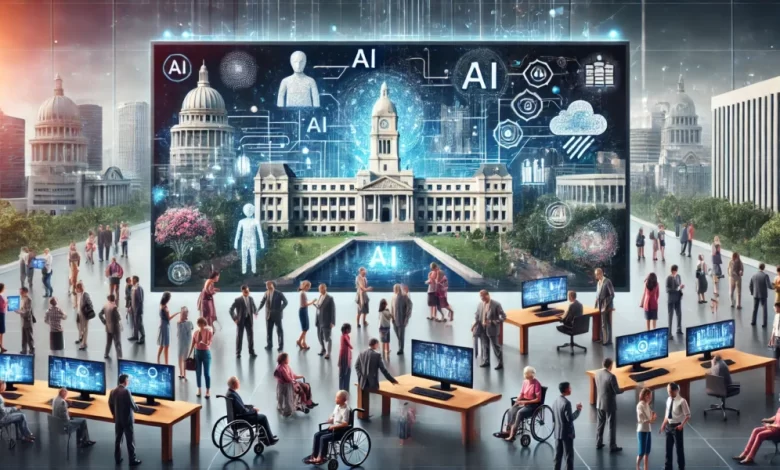Inclusive Governance: How Generative AI is Making Public Services Accessible to All

While the public sector continues to evolve with advancing technology, its core objective remains unchanged: to ensure that all citizens, regardless of their socio-economic status, physical capabilities or geographic location, have equal access to public services. This goal, commonly known as inclusive governance, has led the sector to continually embrace advanced technologies to improve citizen engagement, streamline operations and make informed decisions. In the 1990s, the rise of the Internet led the public sector to adopt e-government, making public services available online and allowing governments to communicate with citizens through websites. Today, generative AI is playing a similarly transformative role, changing the way users interact with services, delivering personalized experiences, improving accessibility, and streamlining workspaces. Recognizing its potential, the public sector is increasingly investing in generative AI, which is expected to increase productivity gains $1.75 trillion per year according to BCG by 2033. This article explores how generative AI is shaping the future of public services and advancing the goals of inclusive governance.
Improve accessibility
Generative AI makes public services more accessible by removing the barriers that have long affected marginalized and disadvantaged communities. Traditional public service models often struggle to reach these groups due to a lack of personalized assistance, language barriers and challenges faced by people with disabilities. Generative AI helps address these issues in several ways:
Generative AI-powered tools like chatbots and virtual assistants provide personalized support, making it easier for people to navigate complex bureaucratic systems. For example, in Heidelberg, Germany, the city has introduced Lumia chatbot that helps citizens and visitors with various questions, from changing addresses to obtaining information about waste collection. Lumi uses publicly available city data and improves over time based on user interactions.
Generative AI-powered translation tools also remove language barriers and ensure non-native speakers have access to important information and services in their preferred language. This is especially important in multicultural societies where language diversity is significant. For example, the cities of Stockton and Fairfield in California have one translation tool that residents can use via mobile or web channels, allowing them to communicate with local governments in 71 languages through Amazon Translate. In India the Jugalbandi The project uses generative AI-powered chatbots on WhatsApp and Telegram to help rural residents access government services in their own language. These chatbots can respond in both text and voice, currently support 10 languages and cover 171 government programs, making it easier for citizens to get the information they need.
Generative AI-powered assistive technologies also improve accessibility for people with disabilities. This is crucial because by 2023 people with at least one disability will have reached a good cause 13 percent of the U.S. population, and their participation in the labor force increased from 21.3 to 22.5 percent between 2022 and 2023. To support these individuals, the U.S. Department of Justice recently issued guidelines requiring state and local governments to ensure that their websites and mobile apps are accessible. Organizations are responding by developing generative AI-powered screen readers such as VoiceOver for iOS and TalkBack for Android, allowing people with visual impairments to navigate government websites and access information more independently.
Increasing citizen involvement
Besides accessibility, another crucial aspect of inclusive governance is establishing effective citizen engagement. Government organizations perform a wide range of functions, from public health initiatives to tourism promotion. When citizens contact agencies with questions, human agents are often challenged to quickly find and summarize this data, which can be time-consuming and labor-intensive. This can sometimes fall short of citizens’ expectations for effective and engaging interactions.
Generative AI-powered virtual assistants help address these challenges by providing personalized answers to citizen questions. For example, EMMA is a chatbot developed by US Citizenship and Immigration Services under the Department of Homeland Security. EMMA helps users with a range of services including immigration, green cards and passports, and supports both English and Spanish. The English version even allows voice interactions, guiding users through the website. EMMA processes approximately 1 million interactions every month, demonstrating its value in improving citizen engagement.
Similarly, the Australian government uses a chatbot called Alex to assist individuals and businesses with tax-related issues, such as property rights, income, withholdings and filing returns. Alex efficiently directs users to relevant content, saving time and improving the overall user experience.
Make an inclusive decision
An important aspect of inclusive governance is fair and unbiased decision-making, regardless of citizens’ socio-economic status, ethnicity or personal connections. Generative AI helps the public sector make inclusive decisions. A notable example of inclusive decision-making in the public sector is the increasing use of a generative, AI-powered automated recruitment process. This system screens resumes and job applications in a way that minimizes human bias. By hiding personal data and focusing only on relevant qualifications and experience, generative AI helps ensure that all candidates are assessed solely on their merits.
For example, the use of generative AI-driven technology in New York City recruitment platforms has created a more diverse candidate pool by standardizing evaluations and removing personal identifiers. In the same way the British civil service uses AI to filter applications and assess diversity, improving the fairness of hiring practices.
Develop inclusive policies
Generative AI is transforming policy development by enabling a more inclusive approach through data analytics. By examining extensive data sets, AI helps identify the needs and preferences of different populations, ensuring that policies reflect the interests of all citizens and lead to fairer outcomes.
The city, for example Los Angeles takes advantage AI-powered analytics to better understand community needs and optimize resource allocation. By analyzing data related to housing, transportation, and public health, the city can make informed decisions that meet the needs of its diverse and often marginalized populations.
In the same way the British National Health Service (NHS) uses generative AI to predict patient demand for healthcare services. This analysis of patient data and trends allows the NHS to allocate resources more effectively, ensuring vulnerable groups get the care they need in a timely manner.
Ensuring responsible use of generative AI in the public sector
While generative AI offers enormous potential for transforming the public sector, it must be used responsibly to ensure that this technology benefits all citizens fairly and equitably. To achieve this, government agencies are developing policies that address these challenges. Examples of such policies include the The EU’s AI lawwhich aims to regulate high-risk AI applications, and the US Algorithmic Accountability Actthat focuses on transparency and fairness in AI systems. Some important guidelines of this policy are:
- Ensure transparency and explainability: Generative AI systems must be designed in such a way that they can function transparently. This requires providing clear explanations of how generative AI makes decisions and ensures that their processes are understandable to non-experts. Transparency helps build trust and ensures that citizens understand how and why decisions are made.
- Ensure honesty and unbiasedness: Generative AI systems can do that unintentional survival or reinforce the biases present in the data they were trained on. To mitigate this risk, it is important to regularly evaluate AI models for potential biases and take corrective action to address any identified issues.
- Prioritize data privacy and security: A major challenge in implementing generative AI in the public sector is ensuring the security of sensitive data. Public sector data is often highly sensitive and must always be protected. To use generative AI effectively, it is critical to ensure that data privacy and security measures are strictly enforced.
- Promoting responsibility: Accountability is a critical aspect of using generative AI to promote inclusive governance. This includes setting up independent bodies or committees to monitor the use and effects of AI systems. It also includes creating public feedback channels to ensure that community input leads to necessary adjustments and improvements.
The bottom line
Generative AI is transforming the public sector by increasing accessibility, increasing citizen engagement, and promoting inclusive decision-making. The ability to provide personalized support, overcome language barriers and help people with disabilities makes public services more equitable and efficient. As government agencies increasingly integrate generative AI, they must deal with challenges around transparency, fairness, and data security. Responsible implementation, guided by robust policies and ethical standards, is essential to ensure that generative AI truly advances the goal of inclusive governance, making services more accessible and equitable for all citizens.






